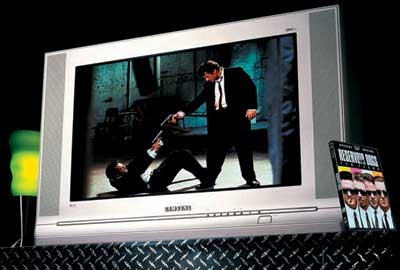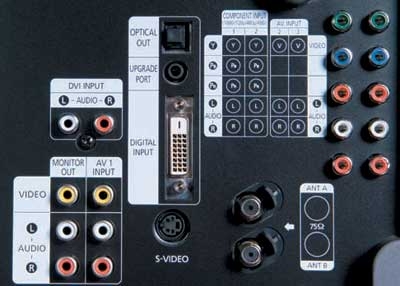HDTV on the Cheap Page 3
Samsung TX-P2670WH At only 26 inches (diagonal), the screen on Samsung's TX-P2670WH looks Lilliputian next to those on other widescreen tube HDTVs. Although the silver plastic frame around the screen is relatively slim, the TV's design is pretty conservative overall. A thin, rounded bar that runs across almost the entire front of the cabinet camouflages a row of control keys and makes the outsized power button look even more prominent. 
|
 As with the other two sets, the Samsung's remote cuts a few corners to hit its price. None of the buttons are backlit, but at least the layout was simple enough to learn by touch. Switching inputs was slower than usual and required me to cycle through all seven of them (there's no way to disable unused jacks). But I did appreciate the dedicated buttons for the component/DVI and antenna inputs. The remote can control external Samsung HDTV tuners and other brands of VCRs, cable boxes, and DVD players. A slide-down door hides lesser-used keys, and four colored buttons give direct access to important functions like picture adjustments and display modes.
As with the other two sets, the Samsung's remote cuts a few corners to hit its price. None of the buttons are backlit, but at least the layout was simple enough to learn by touch. Switching inputs was slower than usual and required me to cycle through all seven of them (there's no way to disable unused jacks). But I did appreciate the dedicated buttons for the component/DVI and antenna inputs. The remote can control external Samsung HDTV tuners and other brands of VCRs, cable boxes, and DVD players. A slide-down door hides lesser-used keys, and four colored buttons give direct access to important functions like picture adjustments and display modes.
The Samsung offers five display-mode choices, including a pair of Zooms and a Panorama mode that stretches the sides of the picture more than the middle. I could use two of them when watching high-def sources: the standard widescreen mode and the 4:3 mode, which places black bars to either side of a standard-shaped TV picture. This last mode is useful since some high-def broadcasts are basically "stretched" versions of standard programs that need to be "unstretched" to look right. Still, the screen's 4:3 image is only 21 inches diagonal.
Along with being able to choose among three picture presets, I could also customize picture parameters like contrast, brightness, and color for each input. Besides the DVI input, the back panel has a pair of component-video inputs, but only one S-video input - a second S-video input is on the side panel, toward the front. 
PICTURE QUALITY I connected my DVD player to one of the component inputs and sat back for another look at Kill Bill, Vol. 1 . After I tweaked the picture, the Samsung set seemed to share many of the performance characteristics of the Toshiba, and watching the movie again confirmed it.
The biggest issue was the tendency to accentuate red. (Tarantino, who toned down the red of the blood in Kill Bill to avoid an NC-17 rating, would probably prefer that you watch his flick on a set like this one.) To my eye, the colors looked garish. Thurman's face, as she pulled her half-paralyzed body across the seats of the hospital orderly's pickup truck, was the color of a crabapple, so I turned the color control way down. This naturally made other colors - like the yellow truck and the blue of her dressing gown - too pale, but it helped make skin tones realistic.
As the camera alternated between extreme closeups of Thurman's feet and face, all the detail I expected to see was there. Tiny lines in her skin, barely visible freckles, and whorls in her gray eyes looked captivating close up, and the signs of chapping on her lips made her recent ordeal seem that much more immediate. While you have to sit fairly close to feel any sense of visual immersion with a TV this small, I could see lots of detail even from 6 feet away.
Next I fired up the D-VHS deck to test DVD vs. HDTV image quality. The amount of detail visible in the shuttle launch sequences on the high-def tape version of Digital Video Essentials was roughly equal to that on the DVD. But that's normal for a tube of this size. Turning to a recording from the satellite receiver, I still enjoyed the beauty of ESPN's high-def SportsCenter , or at least the studio shots, because all the highlights - including the previous night's high-def basketball game - were in standard-definition. The wide shot of the deserted Palace at Auburn Hills looked great, although on a bigger TV the seats in the deep background would have stood out instead of blending together.
In the end, the joys of this little Samsung were its wide screen, built-in high-def tuner, and affordable price. If you can sit close enough without straining your eyes, and like to watch widescreen DVD movies and HDTV shows, it's an incredible value.
- Log in or register to post comments




















































